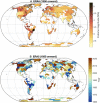The 2021 western North America heat wave among the most extreme events ever recorded globally
- PMID: 35507648
- PMCID: PMC9067932
- DOI: 10.1126/sciadv.abm6860
The 2021 western North America heat wave among the most extreme events ever recorded globally
Abstract
In June 2021, western North America experienced a record-breaking heat wave outside the distribution of previously observed temperatures. While it is clear that the event was extreme, it is not obvious whether other areas in the world have also experienced events so far outside their natural variability. Using a novel assessment of heat extremes, we investigate how extreme this event was in the global context. Characterizing the relative intensity of an event as the number of standard deviations from the mean, the western North America heat wave is remarkable, coming in at over four standard deviations. Throughout the globe, where we have reliable data, only five other heat waves were found to be more extreme since 1960. We find that in both reanalyses and climate projections, the statistical distribution of extremes increases through time, in line with the distribution mean shift due to climate change. Regions that, by chance, have not had a recent extreme heat wave may be less prepared for potentially imminent events.
Figures




References
-
- IPCC, Summary for policymakers, in Climate Change 2021: The Physical Science Basis. Contribution of Working Group I to the Sixth Assessment Report of the Intergovernmental Panel on Climate Change, V. Masson-Delmotte, P. Zhai, A. Pirani, S. L. Connors, C. Péan, S. Berger, N. Caud, Y. Chen, L. Goldfarb, M. I. Gomis, M. Huang, K. Leitzell, E. Lonnoy, J. B. R. Matthews, T. K. Maycock, T. Waterfield, O. Yelekçi, R. Yu, B. Zhou, Eds. (Cambridge Univ. Press, 2021).
-
- Ebi K. L., Capon A., Berry P., Broderick C., de Dear R., Havenith G., Honda Y., Kovats R. S., Ma W., Malik A., Morris N. B., Nybo L., Seneviratne S. I., Vanos J., Jay O., Hot weather and heat extremes: Health risks. Lancet 398, 698–708 (2021). - PubMed
-
- Vicedo-Cabrera A. M., Guo Y., Sera F., Huber V., Schleussner C. F., Mitchell D., Tong S., de Sousa Zanotti Stagliorio Coelho M., Saldiva P. H. N., Lavigne E., Correa P. M., Ortega N. V., Kan H., Osorio S., Kyselý J., Urban A., Jaakkola J. J. K., Ryti N. R. I., Pascal M., Goodman P. G., Zeka A., Michelozzi P., Scortichini M., Hashizume M., Honda Y., Hurtado-Diaz M., Cruz J., Seposo X., Kim H., Tobias A., Íñiguez C., Forsberg B., Åström D. O., Ragettli M. S., Röösli M., Guo Y. L., Wu C. F., Zanobetti A., Schwartz J., Bell M. L., Dang T. N., van D., Heaviside C., Vardoulakis S., Hajat S., Haines A., Armstrong B., Ebi K. L., Gasparrini A., Temperature-related mortality impacts under and beyond Paris agreement climate change scenarios. Clim. Change 150, 391–402 (2018). - PMC - PubMed
-
- Christidis N., Jones G. S., Stott P. A., Dramatically increasing chance of extremely hot summers since the 2003 European heatwave. Nat. Clim. Chang. 5, 46–50 (2015).
LinkOut - more resources
Full Text Sources

